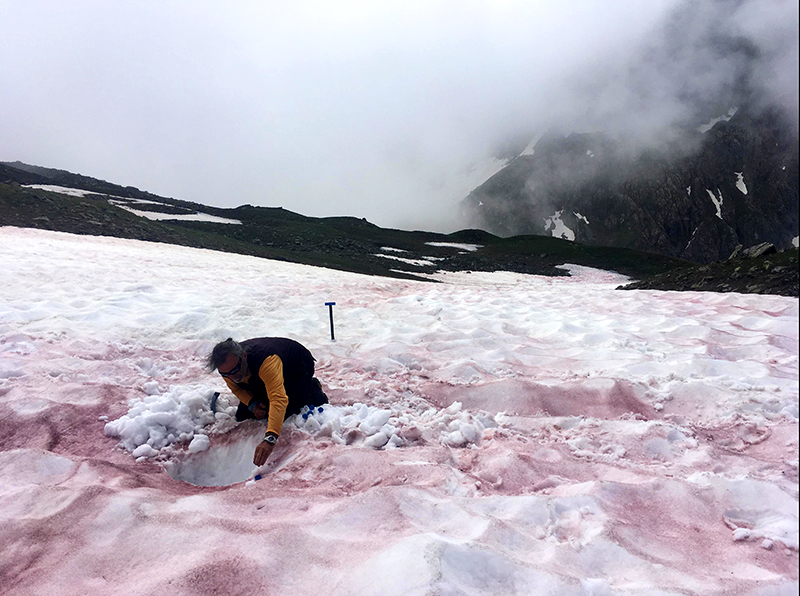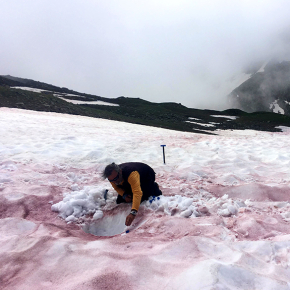
ALPALGA: the search for mountain snow microalgae
|
|
The life of the microscopic algae that inhabit snow at high elevations is still relatively unknown. Researchers from the CNRS, CEA, Météo-France, INRAE and the l’Université Grenoble Alpes have therefore created the ALPALGA consortium to study this little-known world, threatened by global warming. Scientists will publish their initial results in Frontiers in Plant Science on 7 June 2021, describing for the first time the distribution of dozens of mountain microalgae species according to elevation.
In a white ocean, well above sea level, the algae thrive. Normally invisible to the naked eye, they are often spotted by hikers trekking through the mountains in late spring as strikingly coloured stretches of snow, in shades of ochre, orange and red. Known as "glacier blood", this colouring is the result of the punctual multiplication (or bloom) of the microalgae that inhabit the snow.
But apart from this impressive phenomenon, the life and organisation of mountain microalgae communities remains a secret. It is this still unknown ecosystem, now threatened by global warming, that needs to be explored. The ALPALGA1 consortium aims to meet this challenge by organising and pooling research efforts on snow microalgae, and it has already received support from the Agence nationale de la recherche and the Kilian Jornet Foundation.
In an initial study involving three consortium laboratories2 , researchers established the first map of snow microalgae distribution along elevation. In fact, as with vegetation, the different species of algae live at varying elevations on the mountains. The genus Sanguina, for example, which gives a characteristic red colour to the snow, has only been found at altitudes of 2000 metres and above. In contrast, the green microalgae Symbiochloris only live at altitudes below 1500 metres.
These results, obtained by collecting DNA from five Alpine sites, forms the foundation on which ALPALGA will build its work. The scientists will try to answer fundamental questions such as: what species of microalgae inhabit the snow? How can these organisms withstand such extreme temperature and sunlight conditions? Does global warming favour blooms? What effect do blooms have on snowmelt? The aim is to study the process of transformation of this ecosystem in order to promote and protect it.

© Jean-Gabriel VALAY/JARDIN DU LAUTARET/UGA/CNRS
- 1The consortium includes researchers from the Laboratoire de physiologie cellulaire et végétale (CNRS/CEA/INRAE/Université Grenoble Alpes), Laboratoire d'écologie alpine (CNRS/UGA/Université Savoie Mont Blanc), Jardin du Lautaret : découverte et sciences (CNRS/UGA), l’Institut des géosciences de l'environnement (CNRS/IRD/UGA) and the Centre d’étude de la neige du Centre national de recherches météorologiques (Météo-France/CNRS).
- 2The Laboratoire de physiologie cellulaire et végétale (CNRS/CEA/INRAE/Université Grenoble Alpes), le Laboratoire d'écologie alpine (CNRS/UGA/USMB) and the Jardin du Lautaret : découverte et sciences (CNRS/UGA).
Altitudinal zonation of green algae biodiversity in the French Alps. Adeline Stewart, Delphine Rioux, Frederic Boyer, Ludovic Gielly, François Pompanon, Amélie Saillard, Wilfried Thuiller, Jean-Gabriel Valay, Eric Marechal and Eric Coissac. Frontiers in Plant Science, 7 june 2021. DOI:10.3389/fpls.2021.679428


